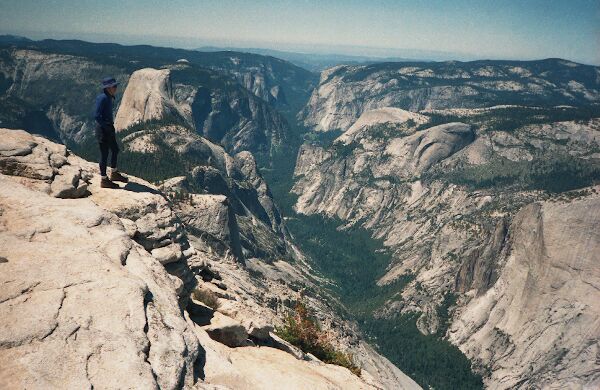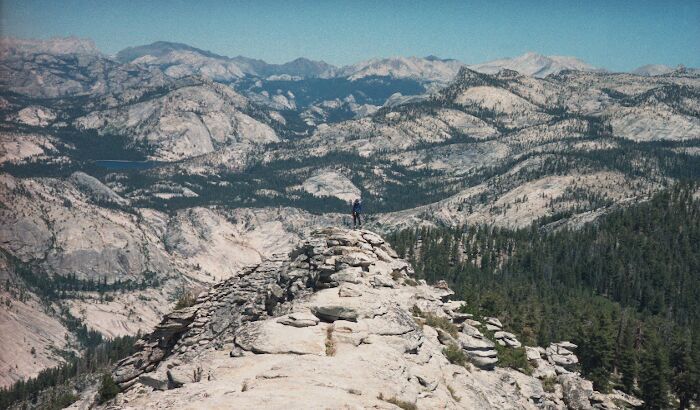
Half Dome

Half Dome and Yosemite Valley as seen from Clouds Rest
Before You Go...
The Hike to Climb Half Dome Handy Advice for hiking Half Dome (particularly in one day!): OK, I am going to hand out some advice here, some of it a repeat of the previous page of the Ottoway Loop story. I think I am qualified to give advice, having hiked just about every trail in the Sierra (several times in many cases) and having been to Half Dome two and a half times. (One time, I got as far as the cables, and they were down and I did not have some safety climbing gear. More on this later.) Anyway, doing the Half Dome hike is not a casual undertaking and requires a modest amount of planning and knowledge. So, read what I have to say, and then you are on your own. In any case, I hereby offer you knowledge and warning, and whatever you do, you are solely responsible for the outcome of your hike.Things you should know
1) First of all, you must be aware that taking on Half Dome as a non-technical hiker/climber, it is an activity defined by the season and conditions. The last stretch of Half Dome is done with the aide of two cables. These cables are held up above the rock about waist high by steel pipes. However, these cable supports are taken down sometime in the fall, and usually replaced sometime in spring for the duration of the fair weather season. When the dome if free of snow in the spring and the park gets around to it, the supports go up. When the weather gets bad in the fall, down they come. Before you plan to do your hike, call ahead and find out if "the cables are up".
2) The Half Dome hike is one of the world's most popular hikes, and as many as 900 people a day do this hike (so a Yosemite Ranger told me). There are literally traffic jams on this trail, and particularly on the cable route part. Weekends during the summer will be the worst. Think about that.
3) Here are extreme hazards on this trail and many people have died: swept over falls, struck by lightening, falling from high places, strokes, heat prostration, exposure, and just normal things that strike unexpectedly. It is a long hard way back to the trailhead, and every year the Park has to chopper out victims. Think, plan ahead, and decide who should do this and not do this hike (like children). It could be a life and death decision. I will point out hazards as we go along in this journal-story. Pay attention.
4) If you are doing Half Dome as a dayhike from Yosemite Valley: Even the most fit will come back from this hike feeling like they were beat with a stick. You must be relatively good condition to do the hike at least! You should prepare for this hike by doing some physical conditioning. Half of all people return from this hike totally exhausted with excruciating (temporary) pain in the knees. By my reckoning, it is 7.5 miles from Happy Isles to the top of Half Dome, and a hair short of 5000 feet of elevation gain. That is a healthy and hard hike for one day, much less something that is only half over! The whole hike round trip from Happy Isles is 15 miles and 5131 feet of gain and loss. This is nothing to sneeze at.
5) The best way to do Half Dome is to spend the night before the hike in Little Yosemite Valley. That knocks off about four miles and 2400 feet of elevation gain from the hike from Happy Isles. Spend another night in Little Yosemite Valley, and the whole affair is just one long pleasant hike and trip. There are many ways to get to Little Yosemite Valley. 1) From Yosemite Valley via Happy Isles trailhead. 2) From Glacier Point via the Panorama Cliff Trail. 3) From Tenaya Lake trailhead over the Clouds Rest trail (the most bang for the buck). 4) From down the Merced River Canyon as in the accompanying story (The Ottoway Lakes Loop). Remember, if you are starting from Tenaya Lakes or Glacier point during the summer, you can take a bus from Yosemite Valley to Tenaya Lake or Glacier Point. Something to think about.
 Looking towards Tenaya Lake from Clouds Rest.
Looking towards Tenaya Lake from Clouds Rest.
I will discuss some of these points in detail. If you are starting from Little Yosemite Valley, this list can and will be modified.
Things you should take along round trip from Happy Isles:
Water: You must carry enough water and a filter for this trip! Every time I have done Half Dome, I ended up giving away most of my water on Half Dome because so many people had run out and were getting pretty dehydrated. There is water all along this trail except the most important part, from Little Yosemite Valley to the top of Half Dome. Oh, there is a spring along that section, but it is hard to find and you cannot be certain it will not be dry when you get there. And what water there is along the whole route must be filtered. In most places of the Sierra I do not bother to filter (but I am choosy from where it comes from). But the Merced River, I don't trust it any further than I can spit it. You should probably drink at least four quarts of water on the hike, and it is only practical to carry two quarts (in a water bladder I suggest). The rest of the water you should filter. This is probably my most important point for your preparation. You should have the carrying capacity of at least 2 quarts and a water filter.
Sun block: People get pretty fried doing this hike. Use sun block, and put it on every stop.
Quick drying layered clothes: Most experienced backpackers already know that cotton kills. If you insist on wearing a cotton T-shirt and shorts, expect them to be a sweat drenched mess by the time you get to the top of Half Dome, and a clammy cold mess on the way back. That is why you carry matches: if the weather turns windy and cool, you can use the Little Yosemite Valley fire-pits for a fire to get dried out, warm up, and avoid dying of exposure. Backup T-shirt and shorts will save you some trouble. Quick drying fabric clothing will save you a lot of trouble. Bring along some warm layers. Just do it.
Flashlights, maybe two: Start this hike as early as you can, like at the crack of dawn. That will give you plenty of time and ample opportunities to rest along the way. In any case, you will probably finish this hike in the dark, particularly after September 1st. It is nice to be able to see when it is dark, so that is why you need a flashlight. (Duh!) A headlamp and a hand flashlight will give you the best results. The hand flashlight has the priority.
Rain Gear: So, it has been clear and hot every day. SO WHAT! The Sierra has a nasty habit of coming up with a thunderstorm or rainstorm unexpectedly, so you must be prepared. The temperature can unexpectedly drop 40 degrees in less than an hour, so you should be prepared for that too. let me say it again: Bring along some warm layers!
Weather: And if there is a thunderstorm building, DO NOT CLIMB HALF DOME!! Being struck by lightening is the number one way to die on Half Dome. I don't care how long you have waited to do this hike or what it has cost you: if a thunderstorm is building, you get your butt back to the trailhead. This is serious. Do not hesitate.
Knees: Probably more than half of all people who attempt Half Dome come back with excruciatingly temporarily painful knees. I see them all the time at the Curry Village cafeteria, people with ice bags on their knees. Mainly, it is the downhill part that kills the knees. When I did a day-hike from Tenaya Lake, over Clouds Rest, up on top of Half Dome and down to Yosemite Valley, everybody with me (except me) was in great knee pain from Half Dome to Yosemite Valley. (Their swearing was awful!) I was in great shape, but I was exhausted. So, if you are not in athletic shape, try proactively taking two ibuprofen (or something as good) at about Nevada Falls and two every couple of hours till the end of the hike and sometimes afterward, if your health and allergies allow it. It will make the pain manageable. Also, rest often on the way up and down. Hiking poles would be a very great help: use two.
Bathroom breaks: There is a restroom near the bridge below Vernal Falls, one near the top of Nevada Falls, and one in Little Yosemite Valley. Bring toilet paper in case they run out, and a trowel in case you get the call of nature far from a restroom.
That should do it for now...